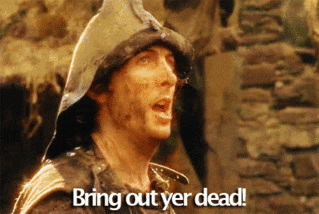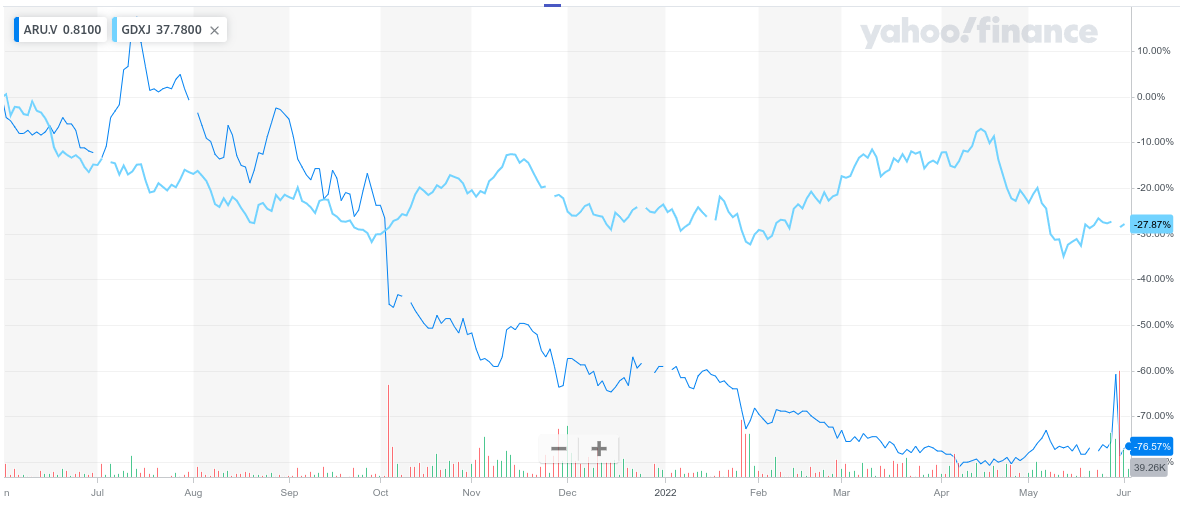Position Review/Post-Mortem - Aurania
Let's talk about one of my portfolio misses. Aurania $ARU.V .


The one year price chart on Aurania is -76%, my position is -79% from my cost basis of C$3.24 now trading at C$0.67. It's been a tough year for the junior mining sector, the $GDXJ is down 27%, but it's been worse for Aurania. To breakeven the position would have to go up 480%. I think this is safely in the bad investment column.

Aurania is still technically in my portfolio. But when a starting position size of 1.25% goes down 79% it becomes pretty irrelevant.
What Did I Get Wrong
Pre-Disovery Explorers
I laid out 3 proven investment strategies for mining: Royalty Companies, Pre-Production Sweet Spot, and Project Generators.

I also laid out 10 unproven invsetment strategies that may or may not work.

Aurania was (and still is) a pre-discovery explorer. It didn't qualify for either list. For pre-discovery explorers this is the typical outcome. I don't have exact numbers but let's say that a successful discovery gives 10x returns, but that an explorer has less than 10% chance of a successful discovery. The exptected return would be negative across a basket of pre-discovery explorers.
If you walk up to a roulette wheel and put a bet on red 16 you might walk away rich, but most likely you will lose your money. Pre-discovery explorers are the roulette wheel.
Large Land Package
207,764 hectares is 2077 square kilometers. That's an area 45 kilometers by 45 kilometers. I viewed that as an asset, surely with that much ground staked out on trend with Fruta Del Norte, Mirador, Wartinza, and other discoveries they would have minable desposits.
In reality a large land package is not an asset, it's a liability. Holding costs for the claims, screening costs, lack of focus. A junior company simply doesn't have the cash to explore that much land.
New District
Nobody had been through doing geologic mapping, soil sampling, anything. This was virgin ground. But because it was a whole new district nobody had any idea what they were looking for or what the signatures looked like.
Tsenken was believed to be a copper porphyry target when it was drilled. Instead after drilling they decided it was an iron oxide copper gold system (IOCG). This is the problem with a new district, you don't even know the regional geology or deposit signatures.
Under Cover / Diamond Scout Drilling
Exploring in areas with minimal outcrop means you don't really know what the rock is under soil/jungle cover. There are ways to explore under cover. Kenorland is doing low cost shallow sonic drilling to get past glacial till cover and sample the top of bedrock. The Aussies are famous for using RC drilling to explore under cover. What these have in common is shallower drilling with lower cost drilling methods.
Aurania's scout drilling under cover were 200m-500m diamond drill holes. That's really deep for scout drilling and is not a low cost drilling method.
Helicopters
Exploration with helicopters is expensive. The dollar per meter drilled goes way way up. As an investor if you see a helicopter in a company photo, report, or presentation you should almost certainly not invest.
There are narrow exceptions if the company has a clear plan to bring in an inexpensive road for future exploration seasons, but it is cheaper to do a small exploration program with a helicopter for the first season.
But generally besides high exploration costs you have to also consider will a potential mine also have high construction and operation costs being so remote?
Social License
Aurania didn't have access agreements to actually explore a pretty significant portion of it's licenses. The Shuar have been vocally opposed to mining, through some of the individual tribes are in favor of mining. But the social license is mixed, and mixed isn't clear unambiguous social license.
Along the way it has meant that Aurania has drilled targets lower down on their prospectivity list over higher ranked targets.
What I Got Rightish
Team
Keith Baron started Aurelian, found Fruta Del Norte. Fruta Del Norte is on trend in Ecuador and is a world class deposit. Keith has put a lot of his own money into Aurania at every stage of the company, participating in most financing rounds. He's feeling the pain way more than small shareholders like me. He's also basically sole-funding the company through this rough patch.
Richard Spencer was President at the time of investment and has since left the company. He spent 10 years exploring in Ecuador. He discovered Loma Larga, a large deposit in Ecuador. He also discovered a porphyry district that includes the only operating porphyry mine in Eduador Mirador, which is on trend to Aurania's claims.
Jurisdiction
At invsetment time Ecuador as a jurisdiction was one of the bigest risks.
Ecuador is becoming a place where it is possible to advance mining projects. Solaris and Solgold have had great stock price runs. Atico recently got their environmental permit, Adventus achieved a milestone on their way to environmental permitting. There have been some investment & tax stability agreements signed with various companies. It's not perfect, the cadastre hasn't started granting exploration applications again yet (though that is rumored to be soon). The regulatory agencies seem to be lacking in regulatory capacity, though trending upward. The courts have had some mixed rulings. Cuenca still had a mining exclusion consultation (popular vote) that likely makes mining in Azuay impossible. But overall I'm pretty happy with this call.
Where Do We Go From Here
Generally I'm pretty good when my thesis doesn't play out of selling at a loss and moving on. I'm not a person who waits for the price to get back to my cost basis.
In classic investing there is this idea of a value trap. A company looks like a good value, but something bad happens to the business and the stock price goes down, but at the new stock price it looks like a good value again. This cycle repeats.
Aurania still looks like good value. They have nice porphyry targets. I think they are open to taking some subset of their land and optioning it out to other companies. I think they could sell or option their Peru assets. They are cheap. Yet, they still don't have a discovery hole.
Against my better judgement I am holding my shares.